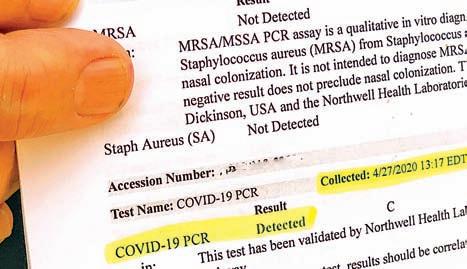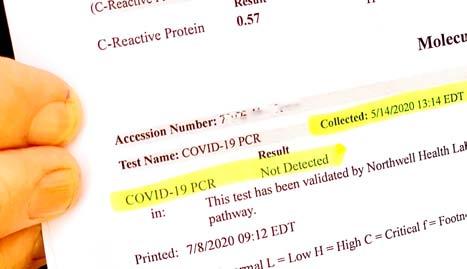
5 minute read
A teacher finds new gratitude for life after his illness
QUEENS STRONG
Forest Hills teacher finds more ‘Wirth’ in life
by Michael Shain Chronicle Contributor
The way Forest Hills teacher Arthur Wirth tells it, surviving the coronavirus is a bit like living through a slow-motion car crash.
The symptoms keep getting worse. But it takes weeks for them to become overwhelming, said Wirth.
The history teacher was diagnosed with the novel coronavirus in the last week of April, though he knew already by the time he called an ambulance for help that he had it.
“I’m a news junkie,” he said. “I had MSNBC on all the time. I had some perspective of what was happening to me.”
Arthur, who is 73 but appears a decade younger, spent three weeks in intensive care and another two months at home under a nurse’s care.
“I never quite thought that I was going to die,” Arthur said, “but I wasn’t sure I was going to live.”
Lying in a special ward set aside in Long Island Jewish Forest Hills hospital, unable to stand or even sit up, “I was afraid I wasn’t ever going to get better,” he said.
Arthur tells his harrowing story in the same flat, matter-of-fact tone that others might use to talk about an unpleasant trip to the Bahamas.
“In early April, my girlfriend noticed my eyes were red,” Arthur said. “That was the first sign.”
A few days later, he began getting tired and short of breath.
Within two or three weeks, “I couldn’t go from the bed to the couch without panting,” he said. His temperature was elevated a few degrees but nothing “severe.”
“I didn’t want to go to the hospital. I thought it was unsafe,” he said.
“I thought I could deal with it at home.”
Then he started to drop weight rapidly, 20 pounds in just a few weeks.
Arthur teaches history at a private school on the West Side of Manhattan. School had been closed since March and he’d been teaching his students remotely from home over a computer hookup.
By the time he called an ambulance on the night of April 26, he’d become so sick he could no longer make it to the computer.
The risk of remaining at home untreated was now worse than the fear of going to the hospital, he concluded reluctantly.
“When I broke down and called the ambulance, I knew it,” he said, meaning he knew he had the virus.
“ I was never quite
— Arthur Wirth
How he contracted the bug Arthur can’t say.
“I didn’t wear a mask early on,” he confessed. “But I don’t know anyone who got it and school had been closed for more than a month.
“I guess I got it from someone passing in the street.”
Hooked up to an oxygen tank and swabbed for COVID, Arthur was admitted immediately. The test came back positive while he was still in the ER, where he was forced to wait for 48 hours until a bed opened up in the hospital upstairs.
“They first put me in a room with people who were really sick, some of them on ventilators,” Arthur said. “It was really scary.”
Hospital discharge records show the teacher was treated with hydroxychloroquine, the controversial drug touted by President Trump and later reported to be substantially ineffective, intravenous steroids and Anakinra, a drug used to treat rheumatoid arthritis that has a track record for keeping COVID patients off respirators.
While the search for a COVID vaccine is in high gear, it is important to remember there is no cure for those who are already infected. Treatment consists of keeping patients in the hospital until the virus either goes away or kills them, Arthur said.
“The only thing they could treat was the pneumonia” that comes with the COVID, doctors told him.
“I have to say this about the people at Forest Hills Hospital: They knew their jobs and they were compassionate. That was important,” he said.
Seventeen days later, he was tested again and found negative.
“I always had a positive feeling I’d get over it because there was always someone in the room in much worse shape than I was,” said Arthur. “They’d wheel them out and they never came back.”
After clearing the infection, “they wanted me out of there fast,” he said. “They needed the bed.”
“They set me up to send me to a rehab facility, but it was in a nursing home. That was the last place I wanted to go.”
It took two days but, on May 16, Arthur was able to negotiate a release to his home under the supervision of a visiting nurse.
Dependent on an oxygen concenArthur Wirth was diagnosed with COVID-19 on April 27 but after two and a half weeks of treatment at Long Island Jewish Forest Hills hospital, he was found free of the disease and soon went home, where he remained under the care of a visiting nurse. PHOTOS BY MICHAEL SHAIN
trator for the first weeks, he was able to go without the device only briefly. “I could take a shower and carry the garbage out to the hallway. That was it,” he said.
The nurse urged him to push himself to do as much as possible without the oxygen as soon as he could. There was a danger of becoming dependent on the tank.
Nine weeks after the night he called the ambulance, Arthur and his girlfriend ventured out of his apartment for the first time. They walked a few hundred feet to the corner and back.
“I definitely have a greater ability to be thankful I’m alive,” he said last week. “I don’t take it for granted anymore.” Q








